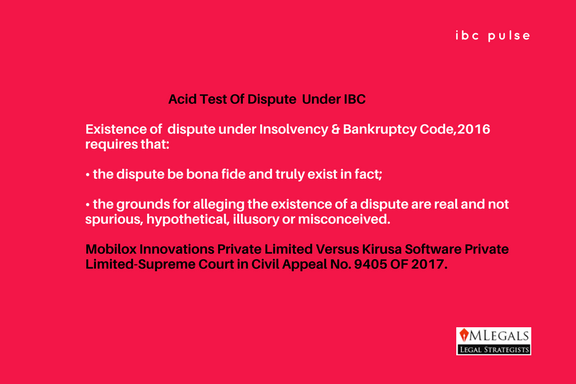“Existence of Dispute” Under IBC,2016

A bench of Supreme Court, comprising of Justice R.F. Nariman and Justice Sanjay Kishan Kaul, in Mobilox Innovations Private Limited Versus Kirusa Software Private Limited, in Civil Appeal No. 9405 of 2017 dealt on the issue of existence of dispute.
Issue
The breach of NDA had resulted non payment of amount by the appellant to the respondent. This led an issuance of demand notice by respondent under Section 8 of the new Insolvency and Bankruptcy Code, 2016.
The appellant responded to the notice of the respondent stating that there exists serious and bona fide disputes between the parties.
The issue after NCLT and NCLAT finally reached to Supreme Court. The Court had to deal on a law point as to what amounts to “existence of dispute” and as to whether the triggering of the Insolvency and Bankruptcy Code, 2016, when it comes to operational debts owed to operational creditors after alleged breach of NDA is justified or otherwise.
Relevant Provision
“5. Definitions. In this Part unless the context otherwise requires,-
(6) “dispute” includes a suit or arbitration proceedings relating to—
(a) the existence or the amount of debt;
(b) the quality of goods or service; or
(c) the breach of a representation or warranty;”
xxx xxx xxx(20) “operational creditor” means a person to whom an operational debt is owed and includes any person to whom such debt has been legally assigned or transferred;
(21) “operational debt” means a claim in respect of the provision of goods or services including employment or a debt in respect of the repayment of dues arising under any law for the time being in
Supreme Court held :
40.It is clear, therefore, that once the operational creditor has filed an application, which is otherwise complete, the adjudicating authority must reject the application under Section 9(5)(2)(d) if notice of dispute has been received by the operational creditor or there is a record of dispute in the information utility. It is clear that such notice must bring to the notice of the operational creditor the “existence” of a dispute or the fact that a suit or arbitration proceeding relating to a dispute is pending between the parties. Therefore, all that the adjudicating authority is to see at this stage is whether there is a plausible contention which requires further investigation and that the “dispute” is not a patently feeble legal argument or an assertion of fact unsupported by evidence. It is important to separate the grain from the chaff and to reject a spurious defence which is mere bluster. However, in doing so, the Court does not need to be satisfied that the defence is likely to succeed. The Court does not at this stage examine the merits of the dispute except to the extent indicated above. So long as a dispute truly exists in fact and is not spurious, hypothetical or illusory, the adjudicating authority has to reject the application.
The Court further held that
43…………………………….Section 5(6) only deals with suits or arbitration proceedings which must “relate to” one of the three subclauses, either directly or indirectly. We have seen that a “dispute” is said to exist, so long as there is a real dispute as to payment between the parties that would fall within the inclusive definition contained in Section 5(6).
45. Going by the aforesaid test of “existence of a dispute”, it is clear that without going into the merits of the dispute, the appellant has raised a plausible contention requiring further investigation which is not a patently feeble legal argument or an assertion of facts unsupported by evidence. The defense is not spurious, mere bluster, plainly frivolous or vexatious. A dispute does truly exist in fact between the parties, which may or may not ultimately succeed, and the Appellate Tribunal was wholly incorrect in characterizing the defense as vague, got-up and motivated to evade liability.
